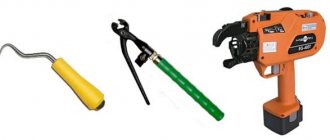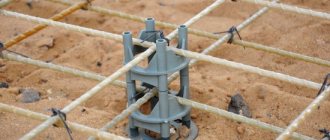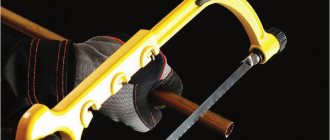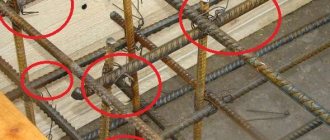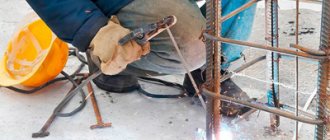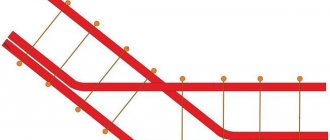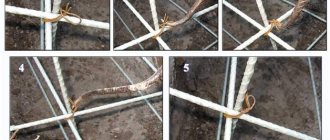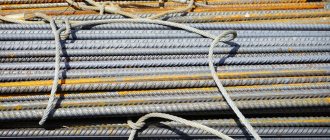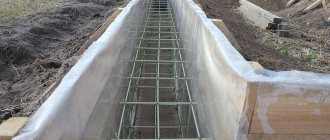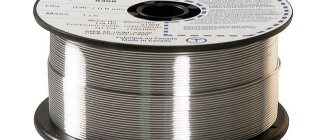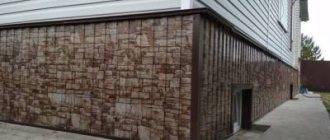Composite reinforcement is one of the modern materials designed to replace expensive rolled metal and provide greater resistance to the negative influence of external factors. After this type of polymer rod began to be produced in Russia in 2012, interest in it from builders began to increase every year.
The use of fiberglass materials for the reinforcement of monolithic concrete structures is especially important in cases of possible exposure to moisture, since polymers are not susceptible to corrosion.
Plastic rods are used at individual development sites, during the construction of large buildings and structures, for coastal fortifications and highways. In private construction, it is used to make reinforcing frames for strip and slab foundations, and also to reinforce masonry made of foam concrete blocks.
The material from which plastic fittings are made is a polymer mixture of longitudinal fiberglass of increased strength and thermally resistant resin. Standard diameters of produced rods range from 4 to 32 mm. Maximum operating temperature 60˚C. Tensile strength 150 MPa.
Preparation of materials for assembling the reinforcing frame
To increase the overall strength of a concrete monolith, it is reinforced with a structure made of fiberglass reinforcement in the form of a flat mesh or spatial frame, which is assembled from round rods of variable or constant cross-section. The individual elements of such structures are connected to each other using binding wire, fixing clamps or a special gun.
Therefore, to knit a reinforcing frame you need to purchase:
- plastic fittings of designed diameters;
- tie wire or tie clamps.
Unlike traditional metal rods, fiberglass reinforcement is supplied in the form of a coiled coil.
Therefore, before starting to assemble the frame, it must be unwound and cut into pieces of the required length. Cutting is done with a hacksaw or other tool that does not allow the material to heat up. Marking cut locations on the surface can be easily done using an ordinary marker.
The binding wire must be round in cross-section and have a diameter of at least 1 mm to ensure the necessary strength of the connection and not burst when twisted. To quickly obtain pieces of wire of the length required for knitting, the entire rolled coil must be cut into 3 or 4 parts with a grinder.
To make the binding wire softer, it can be burned in a flame using a blowtorch or in a fire. Unburnt wire bends worse and does not always provide a tight grip on the joint. In addition, unprepared metal has less ductility and is more likely to break during operation.
Knitting with clamps.
General knitting pattern.
Areas of application
Synthetic reinforcement has found application in various areas of industrial and civil construction . With its help, residential buildings are erected, factory complexes are constructed, used in the installation of technological structures, etc.
The use of composite reinforcement in foundations for low-rise buildings and cottages . In addition, composite rods perform well in concrete structures. This can be wall masonry with flexible ties , as well as the construction of brick and reinforced concrete structures.
Modern builders cannot do without synthetic material even where the use of steel rods is impossible. For example, in frosty conditions , it is necessary to add special additives in the form of hardening accelerators and antifreeze additives to masonry mortars. Such additions have a negative effect on metal rods, but they are harmless for composite reinforcement.
Modern
road construction technologies also provide for the possibility of using synthetic reinforcement.
It is used in the construction of coatings, embankments, and to strengthen other road elements exposed to chemically harmful reagents. As a rule, the use of a composite in this area implies one goal - the creation of a strong bond with strengthening properties. For this purpose, rods are introduced into road slopes, bridge structures and various road surfaces that experience increased traffic loads. Return to content
Wire tying tool
Using pliers for knitting is not very convenient. They do not provide the required connection coverage density and require a lot of effort. Therefore, steel wire is twisted onto reinforcing bars using special hooks or a knitting gun. Tool stores offer for sale two types of hooks designed for tying reinforcement:
- simple manual ones, which must be rotated all the time during operation;
- semi-automatic screw type, with a hook that rotates when you press the handle;
- plastic fasteners in the form of rings and vertical posts that fit onto the reinforcement.
Instead of buying a simple hook, you can make it yourself (read more about how to do this here), bending it from thick steel wire and sharpening the tip. In this case, you will have something to knit a project design from rods without purchasing a tool.
Fastening reinforcement
The reinforcement placed in the frame for pouring concrete is fastened together. In the most critical places, a rigid connection is used. This means that here the rods are welded at the intersection points or secured using threaded couplings.
Methods for tying reinforcement: 1st and 3rd knot, this is a flexible connection; Option 2, welding - rigid fasteners.
In some cases, it is possible to use a flexible connection called a knit. For this, steel wire can be used for tying reinforcement with a diameter of 1-1.4 mm or plastic clamps. This connection is considered reliable, but it is also applicable in construction.
Technology of manual wire knitting of fiberglass reinforcement
In order for the reinforcement frame or mesh to take on the required spatial shape and not change it when concrete is poured, all individual elements must be securely connected to each other. The most common way to do this is to use tie wire. Knitting is a simple and quick joining method that does not require high qualifications. In addition, fiberglass reinforcement simply cannot be connected by welding, and therefore this type of fastening is most suitable in this case.
The entire process of how to knit fiberglass reinforcement for a foundation can be divided into the following step-by-step steps:
- the reinforcement rolled into a coil is unwound and cut into pieces of the designed length;
- plastic clamps are put on the transverse rods of the lower reinforcing layer;
- longitudinal rods are laid on the spaced transverse elements at a specified distance from each other;
- at all intersections of the reinforcement, connections are made by twisting loops of knitting wire folded in half;
- after assembling the bottom row, vertical reinforcing elements are tied to the intersections of the outer cells;
- transverse sections are tied to the upper ends or to the middle of the vertical posts, depending on the design number of rows;
- the next row of longitudinal reinforcement is laid and knitted;
- the assembled frame is transferred and installed inside the formwork for the strip foundation.
The work can be greatly simplified if you combine fiberglass reinforcement with metal. You can prepare rectangular frames from steel rods in advance and then you will not need to perform separate knitting of vertical sections.
Reinforcement made of metal or composite materials?
When deciding which reinforcement to use to strengthen the foundation or walls of a building, you should compare the characteristics of traditional metal and fiberglass products. Compared to metal ones, fiberglass reinforcement has the following advantages:
- exceptional resistance to corrosion: a foundation reinforced with composite reinforcement is not afraid of interaction with acidic, salty and alkaline environments;
- Having low thermal conductivity, fiberglass reinforcement does not create cold bridges, which is a particularly relevant quality for the operation of buildings in the climatic conditions of our country;
- the materials used for the manufacture of fiberglass reinforcement are dielectrics, therefore the foundations and walls for which it is used are absolutely transparent to radio and electromagnetic waves;
- the weight of composite reinforcement is significantly lower than the weight of products made of metal; the strength of fiberglass reinforcement rods is almost 2–3 times higher than that of reinforcement made of metal;
- due to the fact that composite reinforcement is supplied to the customer in coils of 100–150 meters, when strengthening the foundation with its use, it is possible to minimize the number of joints, which, as is known, are the weakest points in any concrete structure;
- purchasing composite reinforcement is more economical due to the fact that you can buy exactly the volume that you need to strengthen the foundation or walls of your building, without focusing on a fixed length of rods, as is the case with metal products;
- the coefficient of thermal expansion of composite materials is almost identical to that of concrete, therefore, practically no cracks occur in the structures for which they are used for reinforcement.
If we compare the cost, then the costs of using metal and fiberglass products are almost the same.
Comparison of metal and fiberglass reinforcement (click to enlarge)
The most significant disadvantage of reinforcement made from fiberglass is its rather low fracture strength, which limits its use for strengthening heavily loaded concrete structures.
The nuances of knitting structures for pouring a slab foundation
Reinforcement of monolithic slab-type support bases is carried out in the form of one or two rows of meshes, depending on the design solution. Therefore, in this design, reinforcing bars are not considered as longitudinal and transverse. To raise the lower mesh above the waterproofing layer, plastic clamps are placed on the reinforcement every one and a half to two meters. This allows you to install the reinforcement cage strictly in a horizontal plane at a given height.
An important feature of assembling reinforcement for a slab foundation is that it is produced locally. This is necessary due to the large size of the structure and the impossibility of subsequent movement. Therefore, during knitting, you must be extremely careful not to step on the laid reinforcing bars and damage the structure.
In the Swedish and Finnish insulated slab (more about it in this article), it is necessary to provide for the intersection of the slab rods with the reinforcing frame of the side support strip. To do this, the rods are cut longer, placed on vertical side reinforcement frames and tied with wire.
Material characteristics
Reinforcement made from composite materials, depending on the continuous reinforcing filler used for its manufacture, is divided into several categories:
- glass composite, which is abbreviated as ASC;
- carbon composite, designated AUK;
- combined or ACC;
- and a number of other categories.
Physical and mechanical parameters of polymer reinforcement of various types
When choosing composite reinforcement to strengthen the foundation or walls of building structures being built, you should take into account its main characteristics:
- the maximum temperature at which these fittings can be effectively operated;
- the tensile strength of the product, measured in tension; this parameter is calculated as the ratio of the applied force to the cross-sectional area of the reinforcing bar; for products of the ASK category it must be at least 800 MPa, and for AUK reinforcement - at least 1400 MPa;
- tensile modulus of elasticity; for carbon composite reinforcement this indicator exceeds the similar characteristic of fiberglass products by more than 2.5 times;
- the tensile strength of a product, measured during its compression; for all types of composite reinforcement this indicator must be at least 300 MPa;
- tensile strength of reinforcement, measured in cross section; for various types of composite reinforcement this indicator should be: for ASK reinforcement - 150 MPa or more; for AUK - more than 350 MPa.
The nuances of knitting fiberglass frames for strip foundations
Features of the assembly of reinforcement for strip foundations include the presence of lateral junctions, intersections and corners.
In places where the tapes meet under the internal walls, the connection of the perpendicular frame with the external one is made using bent U-shaped elements.
In the corners, the reinforcement is bent at a right angle or prepared L-shaped elements are tied. The overlap length of the connected rods must be at least 30 cm and at least 2 knits are performed in this area.
Fiberglass reinforcement should be bent very carefully, without using heat treatment. The elastic properties of plastic make the bending procedure quite difficult. Therefore, to assemble corners and junctions, it is recommended to buy prefabricated bent elements.
The intersections of fiberglass reinforcement under the strip foundation can be connected by straight sections or one of the intersecting structures can be assembled at the installation site.
Knitting with plastic clamps
The use of mounting plastic clamps is the second simplest and fastest method of tying composite reinforcement. This knitting option will cost a little less than the method described above: one clamp costs about 0.5÷0.6 rubles per piece. To tie composite reinforcement with plastic clamps, we proceed as follows: simply tighten the clamp with force at the crosshairs of the reinforcing bars. The connection is strong and reliable. In some places, to provide additional rigidity to the frame, we use two clamps at once, wrapped crosswise around the rods. It is better to remove the excess “tails” remaining after tightening using wire cutters. If this is not done, a capillary will form around the end of the clamp protruding from the concrete structure, through which moisture will get inside (this negatively affects strength and durability).
Meeting work requirements
Considering the many disadvantages of plastic clamps, the following rules must be observed when working with products:
- Once the reinforcement has been coupled, you cannot walk on the mesh. Plastic may not hold up.
- Concrete should be poured carefully. The resulting vibration can disturb the joints. This will lead to disruption of the location of the reinforcement grid in space.
Due to the inability of plastic to withstand tensile forces, even using several clamps to connect one point does not guarantee a reliable connection.
Disadvantages of the mounting method
Using plastic clamps has more disadvantages than advantages. The disadvantages are as follows:
- At subzero temperatures, plastic becomes brittle. This must be taken into account when working in frosty weather.
- Installed products may break under force.
- The number of plastic grips must be purchased in large quantities, which leads to significant additional costs.
- The formed joints are classified as permanent joints. If it is necessary to separate the ligament, the element is cut.
- Plastic products stretch under force. This can lead to a change in the position of the reinforcement after it is poured with concrete.
All these negative points must be kept in mind before starting work.
Positive aspects of using plastic
The use of plastic clamps to connect reinforcement in construction is allowed due to the following advantages of the method:
- Plastic does not corrode.
- Ease of use.
- The material has sufficient strength. Especially if the fastening is carried out at one point by several elements.
- The coupling point is securely secured with a lock.
Such fastening is allowed only in those places where it is permitted on the basis of the construction project. Although externally, the reinforcement connections made with plastic ties look neat and beautiful. Their use is not allowed for the joint of reinforcement that is installed in critical connections.
We recommend watching a video in which a master reinforces a strip foundation with fiberglass reinforcement and assembles the frame using plastic clamps.
